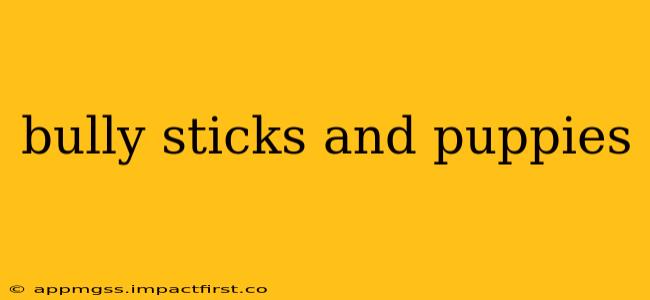Bully sticks are a popular chew for dogs, but are they safe for puppies? The short answer is: it depends. While bully sticks offer several benefits, there are also potential risks to consider, especially for young, teething puppies. This guide will explore the pros and cons, helping you make an informed decision about whether bully sticks are right for your furry friend.
Are Bully Sticks Safe for Puppies?
The safety of bully sticks for puppies depends largely on the puppy's age, size, and chewing habits. Very young puppies with developing teeth may not have the strength to effectively chew a bully stick, potentially leading to choking hazards or digestive issues from swallowing large, undigested pieces. Larger, more robust puppies might handle them better. Regardless of size, supervision is crucial. Never leave a puppy unsupervised with a bully stick.
What are the Benefits of Bully Sticks for Puppies (and Adult Dogs)?
Bully sticks, made from the pizzle (dried penis) of cattle, offer several advantages:
-
Natural and Long-lasting: Unlike many processed chews, bully sticks are a natural product, providing hours of chewing entertainment. This prolonged chewing satisfies a puppy's natural instinct to gnaw, helping to alleviate teething pain and boredom.
-
Dental Hygiene: The chewing action helps to scrape away plaque and tartar buildup on teeth, promoting better oral hygiene. This can reduce the risk of dental disease in the long run.
-
Protein Source: Bully sticks are a good source of protein, providing a healthy nutritional boost. However, they shouldn't replace a balanced diet.
-
Mental Stimulation: Chewing helps to keep puppies mentally stimulated, reducing anxiety and preventing destructive behaviors.
What are the Risks of Giving Bully Sticks to Puppies?
Despite their benefits, bully sticks present some risks:
-
Choking Hazard: Puppies might try to swallow large pieces whole, leading to choking. Always supervise your puppy while they chew and choose appropriately sized bully sticks. Smaller, thinner sticks are generally better for puppies.
-
Digestive Upset: Swallowing large chunks can cause digestive issues such as vomiting or diarrhea.
-
Bacterial Contamination: Although less common with reputable brands, there's always a slight risk of bacterial contamination if the bully stick isn't properly processed or stored.
What Size Bully Stick is Right for My Puppy?
The appropriate size depends entirely on your puppy's breed, size, and chewing ability. Start with a smaller, thinner bully stick and observe your puppy's chewing style. If they are struggling or swallowing large pieces, choose an even smaller size or consider a different chew toy. Err on the side of caution.
How to Safely Introduce Bully Sticks to Your Puppy
- Supervision is Key: Never leave your puppy unsupervised with a bully stick.
- Start Small: Begin with a smaller bully stick than you think they need.
- Observe Closely: Watch your puppy while they chew to monitor for any signs of choking or distress.
- Choose Reputable Brands: Opt for bully sticks from reputable manufacturers that adhere to strict quality and safety standards.
- Remove Remains: Once the bully stick is significantly reduced or your puppy loses interest, remove it to prevent accidental ingestion of smaller pieces.
Alternatives to Bully Sticks for Puppies
If you're hesitant about bully sticks, consider alternatives such as:
- Nylabones: Durable nylon chews designed to withstand rigorous chewing.
- Dental chews: Designed to help with teeth cleaning.
- Frozen Kongs: Filled with healthy treats, these provide mental and physical stimulation.
By carefully considering the risks and benefits and taking appropriate precautions, you can decide whether bully sticks are a suitable choice for your puppy. Remember, responsible pet ownership includes making informed decisions about your pet's diet and toys to ensure their safety and well-being.
